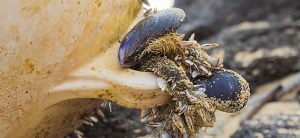Researchers of the Merikotka-driven COMPLETE and COMPLETE PLUS projects published a scientific article where they present a multi-criteria decision analysis model to compare alternative biofouling management strategies in the Baltic Sea. The article is a joint effort of the KMRC researchers from the groups of the University of Helsinki, South-Eastern Finland University of Applied Science, and the Kotka Maritime Research Association, in collaboration with Finnish Environment Institute (SYKE), Natural Resources Institute Finland (LUKE), Chalmers University of Technology, and University of Klaipeda.
Biofouling management helps to prevent the spread of potentially harmful non-native species but is important also in terms of ships’ fuel consumption and CO2 emissions. The main biofouling management methods in use are regular cleaning of the underwater parts of vessels, and diverse biocidal or non-biocidal hull coatings. The ecological and environmental risks associated with different solutions and their combinations should be acknowledged when selecting case-specifically sustainable management strategies. In addition, the special characteristics of the Baltic Sea, such as the partial ice coverage in winter, restrict the applicability of some solutions in the area.
The researchers developed a model that enables case-specific comparison of the biofouling control strategies in relation to the risk of new non-indigenous species introductions in different parts of the Baltic Sea, the eco-toxicological risk due to biocidal hull coatings, and the carbon dioxide (CO2) emissions that increase along the growing friction caused by the organisms attaching the ship’s hull. In addition, for each analyzed scenario, the model estimates the monetary costs for the shipping company, arising from the fuel consumption and the evaluated control options.
In the article, the researchers demonstrate how, with the careful consideration of the hull fouling management strategy, both money and environment can be saved. Biocidal-free coating combined with regular in-water cleaning, using a device to collect the detached organic material, provides a sustainable alternative. However, the optimal biocidal-free coating type and in-water cleaning interval should be evaluated case-specifically. In some cases, biocidal coating with less regular in-water cleaning appears to be a justifiable solution but even then, the copper concentration and release rate from the coating should be adjusted to the low-salinity conditions of the Baltic Sea.
The article is published in the journal Science of the total environment and is freely available. It is part of the KMRC-researcher Emilia Luoma’s PhD study she conducts as part of the research group of the University of Helsinki. In her thesis Luoma applies participatory system modeling methods to examine environmental and sustainability issues related to marine traffic in the Baltic Sea.


